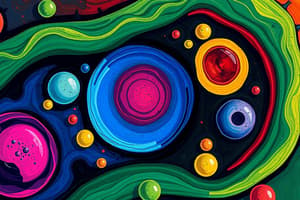Podcast
Questions and Answers
Where does cellular respiration occur in the cell?
Where does cellular respiration occur in the cell?
- Mitochondria (correct)
- Nucleus
- Endoplasmic Reticulum
- Golgi Apparatus
Law of Independent Assortment states that alleles of different genes are always inherited together.
Law of Independent Assortment states that alleles of different genes are always inherited together.
False (B)
What is the main function of lysosomes in a cell?
What is the main function of lysosomes in a cell?
Cellular digestion
Cell division resulting in four non-identical daughter cells is called ____________.
Cell division resulting in four non-identical daughter cells is called ____________.
Match the following cellular organelles with their functions:
Match the following cellular organelles with their functions:
Study Notes
Cell Biology
- Cell Structure:
- Plasma membrane: semi-permeable membrane that surrounds the cell
- Cytoplasm: jelly-like substance inside the cell where metabolic reactions occur
- Nucleus: contains genetic material (DNA)
- Mitochondria: site of cellular respiration
- Ribosomes: site of protein synthesis
- Cellular Organelles:
- Lysosomes: contain digestive enzymes for cellular digestion
- Golgi apparatus: involved in protein modification and transport
- Endoplasmic reticulum (ER): involved in protein synthesis and transport
- Cell Division:
- Mitosis: process of cell division resulting in two identical daughter cells
- Meiosis: process of cell division resulting in four non-identical daughter cells (gametes)
Genetics
- Mendelian Genetics:
- Laws of Inheritance:
- Law of Segregation: each pair of alleles separates during gamete formation
- Law of Independent Assortment: alleles of different genes are sorted independently
- Monohybrid Cross: cross between two true-breeding parents with different alleles of a single gene
- Dihybrid Cross: cross between two true-breeding parents with different alleles of two genes
- Laws of Inheritance:
- DNA Structure:
- Double helix model: two complementary strands of nucleotides
- Nucleotides: composed of sugar, phosphate, and nitrogenous bases (A, C, G, and T)
- Gene Expression:
- Transcription: process of creating mRNA from DNA
- Translation: process of creating protein from mRNA
Cellular Respiration
- Overview:
- Process of generating energy for the cell through the breakdown of glucose
- Occurs in the mitochondria
- Stages:
- Glycolysis: breakdown of glucose into pyruvate (occurs in cytoplasm)
- Citric Acid Cycle (Krebs Cycle): breakdown of pyruvate into ATP, NADH, and FADH2 (occurs in mitochondria)
- Oxidative Phosphorylation: generation of ATP through the electron transport chain (occurs in mitochondria)
Photosynthesis
- Overview:
- Process of generating energy for the cell through the conversion of light energy into chemical energy
- Occurs in the chloroplasts of plant cells
- Light-Dependent Reactions:
- Light absorption by pigments (chlorophyll)
- Conversion of light energy into ATP and NADPH
- Light-Independent Reactions (Calvin Cycle):
- Fixation of CO2 into organic compounds using ATP and NADPH
- Regeneration of RuBP (ribulose-1,5-bisphosphate)
Cell Biology
- Cell Structure:
- Plasma membrane is semi-permeable, allowing certain substances to pass through
- Cytoplasm is the jelly-like substance where metabolic reactions occur
- Nucleus contains genetic material in the form of DNA
- Mitochondria is the site of cellular respiration, generating energy for the cell
- Ribosomes are responsible for protein synthesis
- Cellular Organelles:
- Lysosomes contain digestive enzymes for breaking down cellular waste
- Golgi apparatus is involved in protein modification and transport
- Endoplasmic reticulum (ER) plays a crucial role in protein synthesis and transport
Genetics
- Mendelian Genetics:
- The Law of Segregation states that each pair of alleles separates during gamete formation
- The Law of Independent Assortment states that alleles of different genes are sorted independently
- Monohybrid cross is a cross between two true-breeding parents with different alleles of a single gene
- Dihybrid cross is a cross between two true-breeding parents with different alleles of two genes
- DNA Structure:
- The double helix model consists of two complementary strands of nucleotides
- Nucleotides are composed of sugar, phosphate, and nitrogenous bases (A, C, G, and T)
- Gene Expression:
- Transcription is the process of creating mRNA from DNA
- Translation is the process of creating protein from mRNA
Cellular Respiration
- Overview:
- Cellular respiration is the process of generating energy for the cell through the breakdown of glucose
- It occurs in the mitochondria
- Stages:
- Glycolysis is the breakdown of glucose into pyruvate, occurring in the cytoplasm
- Citric Acid Cycle (Krebs Cycle) is the breakdown of pyruvate into ATP, NADH, and FADH2, occurring in the mitochondria
- Oxidative Phosphorylation is the generation of ATP through the electron transport chain, occurring in the mitochondria
Photosynthesis
- Overview:
- Photosynthesis is the process of generating energy for the cell through the conversion of light energy into chemical energy
- It occurs in the chloroplasts of plant cells
- Light-Dependent Reactions:
- Light absorption by pigments (such as chlorophyll) occurs in the thylakoid membrane
- Light energy is converted into ATP and NADPH
- Light-Independent Reactions (Calvin Cycle):
- CO2 is fixed into organic compounds using ATP and NADPH
- RuBP (ribulose-1,5-bisphosphate) is regenerated
Studying That Suits You
Use AI to generate personalized quizzes and flashcards to suit your learning preferences.
Description
Test your knowledge of cell structure and organelles, including the plasma membrane, nucleus, mitochondria, and more.




